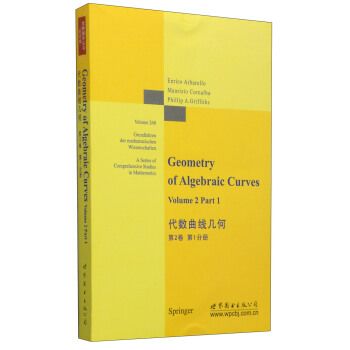《代數曲線幾何(第2卷·第1分冊)》是2014年世界圖書出版公司出版的著作,作者是[意] E.阿爾巴雷洛(Enrico Arbarello。
基本介紹
- 書名:《代數曲線幾何(第2卷·第1分冊)》
- 作者:[意] E.阿爾巴雷洛(Enrico Arbarello
- 出版社:世界圖書出版公司
- 出版時間:2014-08-01
內容簡介,目錄,
內容簡介
《代數曲線幾何(第2卷 第1分冊)》是英文版的代數曲線的書。代數幾何是現代數學的一個重要分支學科。它的基本研究對象是在任意維數的(仿射或射影)空間中,由若干個代數方程的公共零點所構成的集合的幾何特性。這樣的集合通常叫做代數簇,而這些方程叫做這個代數簇的定義方程組。
目錄
Guide for the Reader
List of Symbols
Chapter Ⅸ.The Hilbert Scheme
1.Introduction
2.The idea of the Hilbert scheme
3.Flatness
4.Construction of the Hilbert scheme
5.The characteristic system
6.Mumford's example
7.Variants of the Hilbert scheme
8.Tangent space computations
9.Ci families of projective manifolds
10.Bibliographical notes and further reading
11.Exercises
Chapter Ⅹ.Nodal curves
1.Introduction
2.Elementary theory of nodal curves
3.Stable curves
4.Stable reduction
5.Isomorphisms of families of stable curves
6.The stable model, contraction, and projection
7.Clutching
8.Stabilization
9.Vanishing cycles and the Picard-Lefschetz transformation
10.Bibliographical notes and further reading
11.Exercises
Chapter ⅩⅠ.Elementary deformation theory and some applications
1.Introduction
2.Deformations of manifolds
3.Deformations of nodal curves
4.The concept of Kuranishi family
5.The Hilbert scheme of v-canonical curves
6.Construction of Kuranishi families
7.The Kuranishi family and continuous deformations
8.The period map and the local Torelli theorem
9.Curvature of the Hodge bundles
10.Deformations of symmetric products
11.Bibliographical notes and further reading
Chapter ⅩⅡ.The moduli space of stable curves
1.Introduction
2.Construction of moduli space as an analytic space
3.Moduli spaces as algebraic spaces
4.The moduli space of curves as an orbifold
5.The moduli space of curves as a stack, Ⅰ
6.The classical theory of descent for quasi-coherent sheaves
7.The moduli space of curves as a stack Ⅱ
8.Deligne-Mumford stacks
9.Back to algebraic spaces
10.The universal curve, projections and clutchings
11.Bibliographical notes and further reading
12.Exercises
Chapter ⅩⅢ Line bundles on moduli
1.Introduction
2.Line bundles on the moduli stack of stable curves
3.The tangent bundle to moduli and related constructions
4.The determinant of the cohomology and some applications
5.The Deligne pairing
6.The Picard group of moduli space
7.Mumford's formula
8.The Picard group of the hyperelliptic locus
9.Bibliographical notes and further reading
Chapter ⅩⅣ.Projectivity of the moduli space of stable curves
1.Introduction
2.A little invariant theory
3.The invariant-theoretic stability of linearly stable smooth curves
4.Numerical inequalities for families of stable curves
5.Projectivity of moduli spaces
6.Bibliographical notes and further reading
Chapter ⅩⅤ. The Teichmuller point of view
Chapter ⅩⅥ. Smooth Galois covers of moduli spaces
Chapter ⅩⅦ. Cycles in the moduli spaces of stable curves
Chapter ⅩⅧ. Cellular decomposition of moduli spaces
Chapter ⅩⅨ. First consequences of the cellular decomposition
Chapter ⅩⅩ. Intersection theory of tautological classes
Chapter ⅩⅩⅠ. Brill-Noether theory on a moving curve
List of Symbols
Chapter Ⅸ.The Hilbert Scheme
1.Introduction
2.The idea of the Hilbert scheme
3.Flatness
4.Construction of the Hilbert scheme
5.The characteristic system
6.Mumford's example
7.Variants of the Hilbert scheme
8.Tangent space computations
9.Ci families of projective manifolds
10.Bibliographical notes and further reading
11.Exercises
Chapter Ⅹ.Nodal curves
1.Introduction
2.Elementary theory of nodal curves
3.Stable curves
4.Stable reduction
5.Isomorphisms of families of stable curves
6.The stable model, contraction, and projection
7.Clutching
8.Stabilization
9.Vanishing cycles and the Picard-Lefschetz transformation
10.Bibliographical notes and further reading
11.Exercises
Chapter ⅩⅠ.Elementary deformation theory and some applications
1.Introduction
2.Deformations of manifolds
3.Deformations of nodal curves
4.The concept of Kuranishi family
5.The Hilbert scheme of v-canonical curves
6.Construction of Kuranishi families
7.The Kuranishi family and continuous deformations
8.The period map and the local Torelli theorem
9.Curvature of the Hodge bundles
10.Deformations of symmetric products
11.Bibliographical notes and further reading
Chapter ⅩⅡ.The moduli space of stable curves
1.Introduction
2.Construction of moduli space as an analytic space
3.Moduli spaces as algebraic spaces
4.The moduli space of curves as an orbifold
5.The moduli space of curves as a stack, Ⅰ
6.The classical theory of descent for quasi-coherent sheaves
7.The moduli space of curves as a stack Ⅱ
8.Deligne-Mumford stacks
9.Back to algebraic spaces
10.The universal curve, projections and clutchings
11.Bibliographical notes and further reading
12.Exercises
Chapter ⅩⅢ Line bundles on moduli
1.Introduction
2.Line bundles on the moduli stack of stable curves
3.The tangent bundle to moduli and related constructions
4.The determinant of the cohomology and some applications
5.The Deligne pairing
6.The Picard group of moduli space
7.Mumford's formula
8.The Picard group of the hyperelliptic locus
9.Bibliographical notes and further reading
Chapter ⅩⅣ.Projectivity of the moduli space of stable curves
1.Introduction
2.A little invariant theory
3.The invariant-theoretic stability of linearly stable smooth curves
4.Numerical inequalities for families of stable curves
5.Projectivity of moduli spaces
6.Bibliographical notes and further reading
Chapter ⅩⅤ. The Teichmuller point of view
Chapter ⅩⅥ. Smooth Galois covers of moduli spaces
Chapter ⅩⅦ. Cycles in the moduli spaces of stable curves
Chapter ⅩⅧ. Cellular decomposition of moduli spaces
Chapter ⅩⅨ. First consequences of the cellular decomposition
Chapter ⅩⅩ. Intersection theory of tautological classes
Chapter ⅩⅩⅠ. Brill-Noether theory on a moving curve

